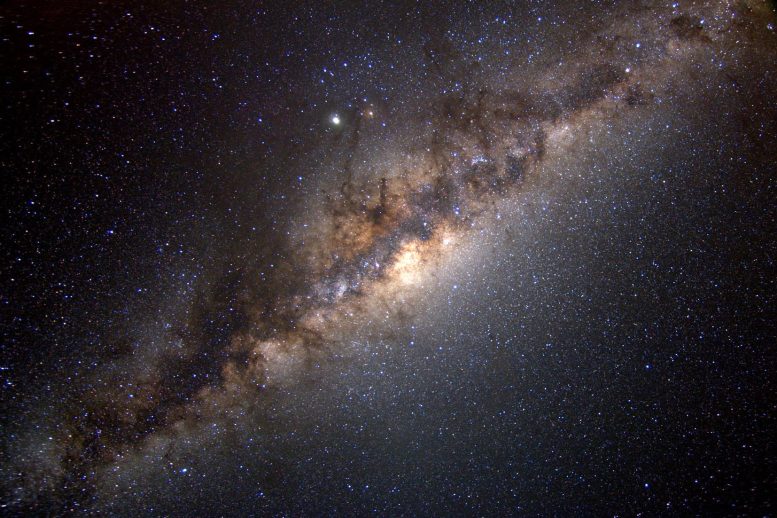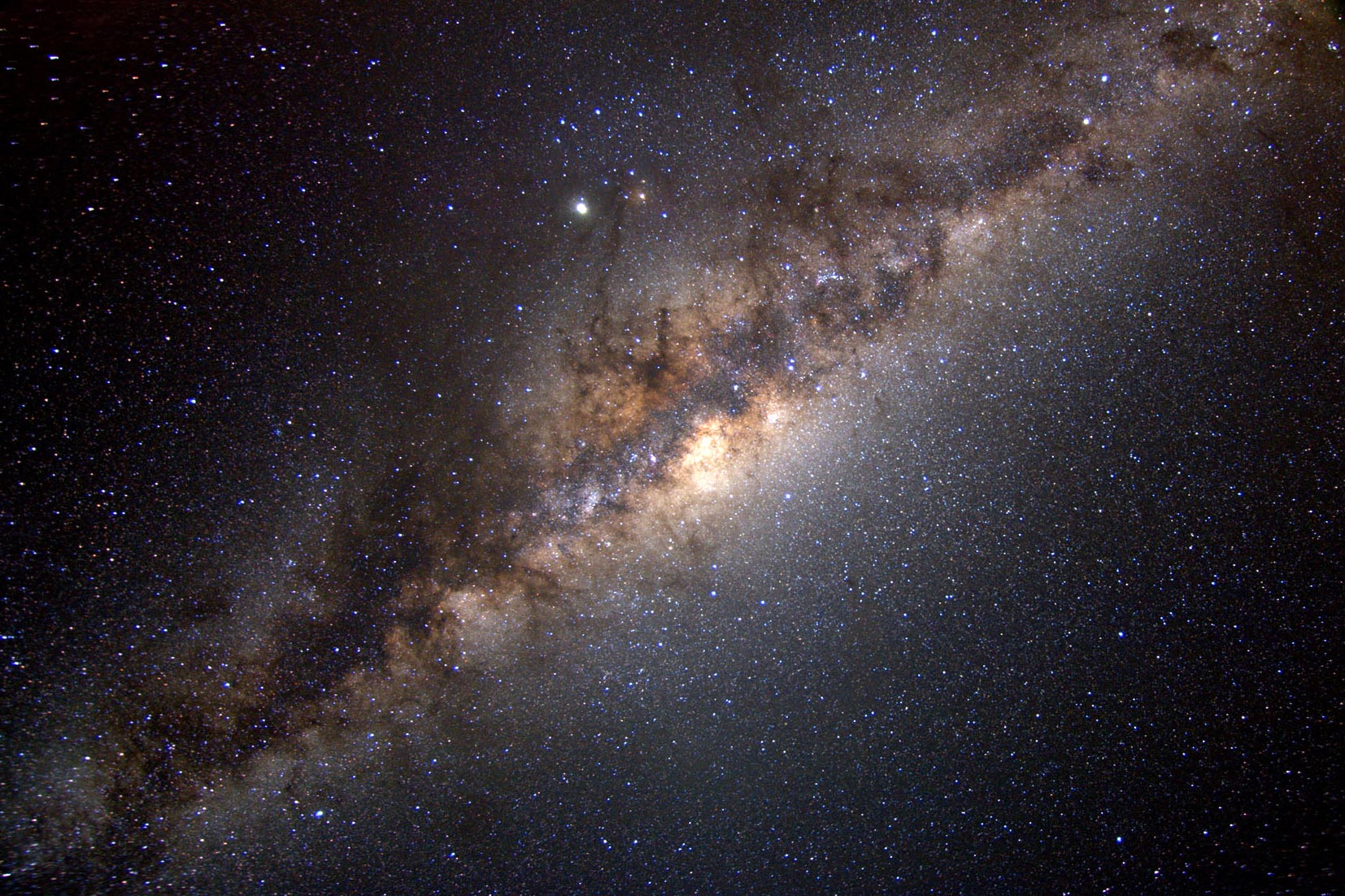
MIT astronomers have discovered three of the oldest stars in the universe, living in our galactic neighborhood. The stars are located in the Milky Way’s “halo” — the cloud of stars surrounding the main galactic disk — and appear to have formed between 12 and 13 billion years ago, when the first galaxies were forming. Credit: Serge Prunier. NASA
Astronomers have discovered three ancient stars orbiting planet Earth milky wayA halo formed 12-13 billion years ago.
Massachusetts Institute of Technology Researchers have discovered three of the oldest stars in the universe, and they happen to live in our galactic neighborhood.
The team, which includes several undergraduate students, discovered stars in the Milky Way’s “halo” — the cloud of stars covering the entire main galactic disk. Based on the team’s analysis, the three stars formed between 12 and 13 billion years ago, the time when the first galaxies formed.
The researchers named the system’s small, accreting stars “SASS”, as they believe each star once belonged to its own small, primordial galaxy that was absorbed by the larger, still-growing Milky Way. Today, the three stars are all that remains of their galaxies. They orbit the outskirts of the Milky Way, where the team suspects there may be more survivors of ancient stars.
A new way to study ancient stars
“These older stars are definitely out there, given what we know about galaxy formation,” says Anna Frebel, a professor of physics at MIT. “They are part of our cosmic family tree. We now have a new way to find them.”
As they discover similar SASS stars, researchers hope to use them as counterparts to ultra-faint dwarf galaxies, which are believed to be some of the first surviving galaxies in the universe. Such galaxies remain intact to this day, but they are too distant and faint for astronomers to study them in depth. Since SASS stars may have once belonged to similar primordial dwarf galaxies but are in the Milky Way and therefore much closer, they may be an accessible key to understanding the evolution of ultra-faint dwarf galaxies.

Researchers keep a file full of data about the stars they’ve collected over the years, including the brightness of the stars over time. From left to right: Ananda Santos, Casey Feinberg, and Anna Frebel. Credit: Courtesy of researchers
“Now we can look for more analogues in the Milky Way, which are much brighter, and study their chemical evolution without having to chase these very faint stars,” says Friebel.
She and her colleagues published their findings on May 14 in the journal Monthly Notices of the Royal Astronomical Society (MNRAS). Co-authors of the study are Muhammad Mardini, of Zarqa University in Jordan; Hillary Andalis ’23; and current MIT undergraduates Ananda Santos and Casey Feinberg.
The classroom concept leads to a major discovery
The team’s discoveries stemmed from the classroom concept. During the fall 2022 semester, Fripple launched a new course, 8.S30 (Observational Stellar Archaeology), in which students learned ancient stellar analysis techniques and then applied those tools to stars that had not been studied before, to determine their origins.
“While most of our classes are taught from the ground up, this class immediately puts us at the forefront of research in astrophysics,” Andalis says.
The students worked with star data that Friebel collected over the years from the 6.5-meter Magellan-Clay Telescope at Las Campanas Observatory. She keeps paper copies of the data in a large file in her office, which students have combed through looking for stars of interest.
In particular, they were looking for ancient stars that formed shortly after the Paleolithic the great explosionWhich happened 13.8 billion years ago. At this time, the universe was composed mostly of hydrogen and helium and very low percentages of other chemical elements, such as strontium and barium. So, the students searched Friebel’s file for stars with spectra, or measurements of starlight, that indicated low abundances of strontium and barium.
Analysis of ancient stars
They narrowed their search to three stars that were originally observed by the Magellan telescope between 2013 and 2014. Astronomers have never followed these stars specifically to interpret their spectra and deduce their origins. They were therefore ideal candidates for the students in Friebel’s class.
Students learned how to characterize a star in order to prepare for spectral analysis of each of the three stars. They were able to determine the chemical composition of each using different stellar models. The intensity of a given feature in the stellar spectrum, corresponding to a given wavelength of light, corresponds to a given abundance of a given element.
After completing their analysis, the students were able to confidently conclude that the three stars contained very low amounts of strontium, barium and other elements such as iron, compared to their reference star – our Sun. In fact, a single star contains less than 1/10,000 the amount of iron to helium than the Sun does today.
“It took many hours of staring at the computer, a lot of debugging, and frantically texting and emailing to figure it out,” Santos recalls. “It was a big learning curve and a special experience.”
“the term”
The stars’ low chemical abundances indicate that they originally formed 12 to 13 billion years ago. In fact, its low chemical signature was similar to what astronomers had previously measured for some ancient, ultra-faint dwarf galaxies. Did the team’s stars originate in similar galaxies? How did they reach the Milky Way?
Based on their hunch, scientists examined the orbital patterns of stars and how they move across the sky. The three stars are located in different locations throughout the Milky Way’s halo, and are estimated to be about 30,000 light-years away from Earth. (For reference, the disk of the Milky Way Galaxy extends 100,000 light-years across.)
When they tracked the motion of each star around the galactic center using observations from the Gaia astronomical satellite, the team noticed something strange: For most of the stars in the main disk, which move like cars on a race track, all three stars appeared to be the same. You’re going the wrong way. In astronomy, this is known as “retrograde motion” and is an indication that an object has been “accumulating” or being pulled from somewhere else.
“The only way you can make stars go in the wrong direction from the rest of the gang is to throw them in the wrong direction,” says Friebel.
Future prospects and research
The fact that these three stars were orbiting in very different ways from the rest of the galactic disk and even the halo, combined with the fact that they had low chemical abundances, made a strong case that the stars were indeed ancient and had once belonged to older stars. They are smaller dwarf galaxies that fell into the Milky Way at random angles and continued their stubborn paths billions of years later.
Frebel was interested in knowing whether retrograde motion was a feature of other ancient stars in the halo that astronomers had previously analyzed, so he searched the scientific literature and found 65 other stars, also containing low abundances of strontium and barium, which also seemed to go against the theory. galactic flow.
“It’s interesting that they’re all very fast; hundreds of kilometers per second, going in the wrong direction,” Fripple says. “They’re on the run! We don’t know why this happened, but it was the piece of the puzzle we needed, and one I didn’t quite expect when we started.”
The team is eager to search for other ancient SASS stars, and they now have a relatively simple recipe for doing so: first, look for stars with low chemical abundances, then trace their orbital patterns for signs of retrograde motion. Of the more than 400 billion stars in the Milky Way, they expect this method to give rise to a small but significant number of the universe’s oldest stars.
Fripple plans to relaunch the class this fall, and looks back on the first course, and the three students who took their results to publication, with admiration and gratitude.
“It was great to work with three female undergraduates. This is a first for me,” she says. “It’s really an example of the MIT way. We do. Whoever says: I want to participate, can do it, and good things will happen.
Reference: “Oldest stars with low abundances of neutron-capturing elements and their origins in ancient dwarf galaxies” by Hilary Diane Andalis, Ananda Santos Figueiredo, Casey Gordon Feinberg, Muhammad K. Mardini, and Anna Friebel, 14 May 2024, Monthly Notices of the Royal Astronomical Society.
doi: 10.1093/mnras/stae670
This research was supported in part by the National Science Foundation.

“Typical beer advocate. Future teen idol. Unapologetic tv practitioner. Music trailblazer.”







More Stories
Boeing May Not Be Able to Operate Starliner Before Space Station Is Destroyed
How did black holes get so big and so fast? The answer lies in the darkness
UNC student to become youngest woman to cross space on Blue Origin